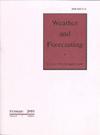The First Operational Version of Taiwan Central Weather Bureau’s One-tier Global Atmosphere-Ocean Coupled Forecast System for Seasonal Prediction
IF 3
3区 地球科学
Q2 METEOROLOGY & ATMOSPHERIC SCIENCES
引用次数: 0
Abstract
The first version of the Taiwan Central Weather Bureau one-tier (TCWB1T) fully coupled global atmospheric and oceanic modeling forecast system had been developed and implemented as a routine operation for seasonal prediction at Central Weather Bureau (CWB) in 2017, with a minor revision in 2020. Based on NCEP CFSv1, the global atmospheric model in NCEP CFSv1 was replaced by CWB’s atmospheric global spectral model (GSM) and coupled with the GFDL MOM3. Several parameters have been tested and tuned in the CWB atmospheric GSM, achieving an optimal configuration with better sea surface temperature (SST) predictions for integration more than one year. Using NCEP CFSR as the initial condition, TCWB1T conducted hindcast from 1982 to 2011 and forecast from 2012 to 2019 for analyzing its performance. The results of hindcast and forecast show that the TCWB1T has useful predictions as verified to the observation of OISST, ERSST, CFSR, and GPCP based on the methods of EOF, RMSE, anomaly correlation, RPSS, RD, and ROC. And TCWB1T has the same level of skill scores as compared to NCEP CFSv2 and/or ECMWF SEAS5, based on EOF, APC, climatological bias, RMSE, temporal correlation, and anomaly correlation percentage of forecast skill. TCWB1T shows forecast skills which are better in winter than summer. Overall, it indicates that TCWB1T can be used for seasonal ENSO predictions.台灣中央氣象局全球大氣-海洋一層式季節預測耦合預報系統首度運作版本
台湾中央气象局单层(TCWB1T)全耦合全球大气与海洋模式预报系统第一版已于2017年开发完成,并作为中央气象局(CWB)季节预报的常规业务实施,2020年将进行小幅修订。在 NCEP CFSv1 的基础上,将 NCEP CFSv1 中的全球大气模式替换为 CWB 的大气全球谱模式(GSM),并与 GFDL MOM3 相耦合。对 CWB 大气全球光谱模式中的几个参数进行了测试和调整,实现了最佳配置,对整合一年以上的海面温度(SST)进行了更好的预测。以 NCEP CFSR 为初始条件,TCWB1T 进行了 1982 年至 2011 年的后预报和 2012 年至 2019 年的预报,以分析其性能。后报和预报结果表明,基于 EOF、RMSE、异常相关性、RPSS、RD 和 ROC 等方法,TCWB1T 与 OISST、ERSST、CFSR 和 GPCP 的观测结果相比较,具有很好的预报效果。与 NCEP CFSv2 和/或 ECMWF SEAS5 相比,基于 EOF、APC、气候学偏差、RMSE、时间相关性和异常相关性的预报技能百分比,TCWB1T 具有相同的技能得分水平。TCWB1T 在冬季的预报能力优于夏季。总体而言,这表明 TCWB1T 可用于季节性厄尔尼诺/南方涛动预报。
本文章由计算机程序翻译,如有差异,请以英文原文为准。
求助全文
约1分钟内获得全文
求助全文
来源期刊

Weather and Forecasting
地学-气象与大气科学
CiteScore
5.20
自引率
17.20%
发文量
131
审稿时长
6-12 weeks
期刊介绍:
Weather and Forecasting (WAF) (ISSN: 0882-8156; eISSN: 1520-0434) publishes research that is relevant to operational forecasting. This includes papers on significant weather events, forecasting techniques, forecast verification, model parameterizations, data assimilation, model ensembles, statistical postprocessing techniques, the transfer of research results to the forecasting community, and the societal use and value of forecasts. The scope of WAF includes research relevant to forecast lead times ranging from short-term “nowcasts” through seasonal time scales out to approximately two years.
 求助内容:
求助内容: 应助结果提醒方式:
应助结果提醒方式:


